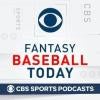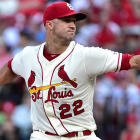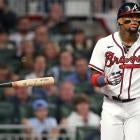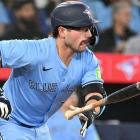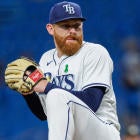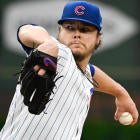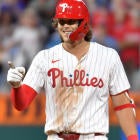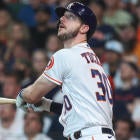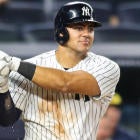Something about football season, man. Come that time of year, a certain segment of the Fantasy Baseball-playing world just ... checks out.
Maybe they have nothing more to play for. Maybe they were never that invested in the first place. Or maybe the beckon of football is like the Siren's song, just impossible to resist.
But baseball kept happening, even if you weren't around to witness it, and certain developments during that time you checked out were nothing short of seismic. I'm here to bring you up to speed, even all these months later.
Here's a breakdown of some of the most notable developments from roughly Aug. 1 on:
- Jorge Soler went from being an all-or-nothing power bat, which would have been enough of a breakthrough given how underwhelming the first five years of his career were, to an all-around offensive force, cutting down on his strikeouts and upping his line-drive rate to hit .306 with 20 homers and a 1.108 OPS over the final two months. He has basically become what we keep hoping Giancarlo Stanton will still be, but to Fantasy Footballers, he's still just that Cubs reject who only the Royals would take on.
- Matthew Boyd couldn't keep the ball in the yard anymore, giving up 16 of his 39 homers over his final nine starts and leading all pitchers with 1.9 home runs per nine innings. His strikeout and walk rates are both top-of-the-line, but his 4.32 FIP along with the league's second-highest fly-ball rate suggests his 4.56 ERA was mostly deserved. It may take more than a trade out of Detroit to make him a high-end starting pitcher.
- Eloy Jimenez finished with a flourish, batting .325 with 12 homers and a .992 OPS over his final 39 games to give him a .267 batting average, 31 home runs and .828 OPS for the season — numbers that didn't exactly shortchange some of the more optimistic projections for him heading into the season. Yeah, the plate discipline could have been better, but there's clearly enough here to renew enthusiasm for 2020 after many had probably written off his rookie year as a failure.
- Turns out Caleb Smith may not be the Marlins' best pitcher after a 6.49 ERA over the final two months inflated his season mark from 3.43 to 4.52. Maybe fatigue simply set in for a mostly untested pitcher, but his fastball became less effective as he leaned on it more and the walks and home runs both went up. Giving the benefit of the doubt to a 28-year-old with a FIP and xFIP both over 5.00 and a supporting cast that probably condemns him to a losing record sounds like a losing strategy.
- Sandy Alcantara, on the other hand, may well be the Marlins' best pitcher, as foretold by his curious (at least at the time) All-Star selection. He was still a below-average bat-misser down the stretch, but by taking the unconventional step (for 2019, that is) of emphasizing his sinker over his four-seamer, he greatly improved his command and efficiency, going seven innings or more in seven of his final 10 starts for a 2.73 ERA. There was no doubt some BABIP luck, but it was enough of a step forward to suggest a pitcher with a top prospect pedigree is on the right track.
- Reports of Bryce Harper's demise have been greatly exaggerated. After his strikeout rate spiked early in the season, furthering a troubling development from 2018, he got better and better as the year went on, eventually batting .277 with 17 homers and a .970 OPS over the final two months. It wasn't MVP-level Harper, but it was enough to ensure he'll be drafted relatively early again next season, even if outside the first three rounds.
- While nothing in the underlying data points to a dramatic transformation for Mike Foltynewicz in his August return from a six-week stint in the minors, it's hard to argue with the results. He went from having a 6.37 ERA in 11 starts before the demotion to a 2.65 ERA in 10 starts afterward. The narrative is that he regained the confidence in his slider after a preseason elbow injury took it away, and he was throwing it a little more after returning. It's enough to reinstate him as a probable mixed-league target.
- Unwarranted hype machine Kyle Schwarber may have turned a corner in his development. It's not just that he hit .304 with 14 homers and a 1.043 OPS over the final two months but also that he reduced his strikeout rate and upped his line-drive rate, two changes he'll need to sustain to get his batting average up. His xBA and xwOBA were both lower than his actual marks during what was already a career-best season.
- Garrett Hampson finally did live up to all the preseason hype. It's just that it was completely confined to the final two weeks — or 16 games, to be more precise, in which he hit .343 (24 for 70) with five homers, seven steals and only 13 strikeouts. That sort of steals pace alone should earn him plenty of Roto buzz again if the Rockies can carve out time for him at second base, center field or both.
- Of course, the Rockies will need to make way for Sam Hilliard as well, who himself just so happens to fit best in center field. The 25-year-old rookie struck out too much at Triple-A but also showed massive power that carried over to the big leagues with seven homers, four doubles and two triples in 77 at-bats. And because he runs, too, swiping 24 bases between the two levels, he's someone to root for in Fantasy. The BABIP-boosting effect of Coors Field has been known to smooth over strikeout problems in the past, so it's largely a question of the Rockies' willingness to turn the page from Ian Desmond and Daniel Murphy.
- Austin Hays has made himself relevant again, batting .309 (21 for 68) with four homers, a .947 OPS and just 13 strikeouts as a September call-up. The former top prospect who climbed from high Class A to the majors during a massive 2017 season, looked like he might be back in the fold when he hit .351 with five homers this spring, but another lackluster showing in the minors took him back off the Fantasy radar. Now 24, he should have the inside track on a starting job next spring.
- Eduardo Rodriguez's 19 wins of course earned him a bump in Fantasy stature, but since they're sure to be dismissed as fluky (and I'm not saying wrongfully), it's worth pointing out how effective he was down the stretch. Some smoke and mirrors in August, when his strikeouts took a dip, but in six September starts, he compiled a 3.11 ERA, 1.19 WHIP and 12.7 K/9.
- As impossible as it may be to believe for those of us who've kept a close watch on things, the whole Aristides Aquino saga was contained to August and September, so it's possible those who checked out for Fantasy Football haven't even heard the name before ... which may be for the best. After rewriting the record books with 11 homers in his first 16 games, the 25-year-old hit .227 with eight home runs in his final 40. He certainly has power, homering 47 times between the majors and minors, but is he a disciplined enough hitter to get the most out of it?
- J.D. Davis made a case for becoming a Mets regular even though he was in and out of the lineup with most everyone back to full health in September. Still, he ended up hitting .321 with 12 homers and a .974 OPS over the final two months, and while he finished with a .307 batting average and .895 OPS, his xBA and xwOBA both suggest he slightly underachieved.
- Mark Canha isn't some small-time platoon guy you can safely ignore anymore. From July 7 on, he was an everyday player for the Athletics, playing primarily center field, and I dare say thrived in the role, batting .300 with 14 homers, a .413 on-base percentage and .941 OPS. The BABIP was on the high side, but the production was fairly steady, suggesting we probably haven't seen the last of him as a viable mixed-leaguer.
- Jack Flaherty ended up being the top Fantasy pitcher in the second half, but he took a 4.64 ERA into the All-Star break. He lowered it every start from that point forward, compiling a 0.91 ERA, 0.71 WHIP and 11.2 K/9 over his final 15 starts. It so drastically transformed his season-long numbers that accepting him as an ace may not be too difficult for the Fantasy Footballers next year. But it'll still catch them by surprise.
- Yu Darvish had the most dramatic in-season transformation for a starting pitcher, though, and since his final ERA was still only a modest 3.98, it may be lost on those who weren't around to see it. Coming off a disastrous 2018 season, the 33-year-old was written off by most when he had a 5.01 ERA through July 3 this year, but the stuff played up once he got back to throwing strikes. After walking 49 in those first 18 starts, he walked just seven in his final 13, and the result was a 2.76 ERA, 0.81 WHIP and 13.0 K/9.
- First-half darling Luke Voit returned from a sports hernia in late August to hit .200 with two homers in 80 at-bats. Meanwhile, Mike Ford, another long-time minor-leaguer only now getting a shot in his late 20s, hit .338 with nine homers over his final 80 at-bats, setting up another possible first base battle for the Yankees next spring. Ford, after all, has a much higher contact rate along with the fly-ball and hard-hit rates befitting a power hitter. You can't assume anything for Voit moving forward.
- Jeff McNeil: power hitter? It certainly seems that way. After making his bones as a contact-first guy, the 27-year-old exploded for 17 homers over the final three months, giving him 23 overall. Though he was a valuable option in Fantasy even before then, this sort of transformation opens a new world of possibilities, provided it's legitimate. And seeing as he hit 19 homers in just 339 at-bats between two minor-league stops last year, I think it is.
- The Twins' Luis Arraez may have replaced McNeil as the preeminent contact-first guy, playing virtually every day between second base and left field and batting .334. Considering his strikeout and line-drive rates would have both led the league if he had the at-bats to qualify, it's about as believable as a .334 batting average can be, and the minor-league track record backs it up, too. He offers nothing in the way of power or speed, though.
- Mookie Betts is still awesome. You may have presumed as much even when he was hitting .272 at the end of the first half, but a .325 batting average and .992 OPS the rest of the way reaffirmed it to all. The steals still weren't what we're used to seeing from him, but he's a top-five pick next year for sure.
- Jose Berrios did it again, once again lulling us into believing he's a surefire ace only to collapse when it matters most, his ERA jumping from 2.80 to 3.68 over the final two months. All it took was a 5.83 ERA in 10 starts during that span, and it should have been easy enough to see coming. He had less than a strikeout per inning for the year and wasn't a great source of ground balls either, so it was mostly just his control and big workload setting him apart. The final ERA still looks pretty nice compared to his 4.32 xFIP.
- True, it began in July, but Sonny Gray's reconstruction fully came to fruition in August and September, when he put together a 1.78 ERA, 0.99 WHIP and 11.1 K/9 across 10 starts. After struggling to get on the same page with the Yankees coaching staff, he has finally settled on a pitch selection that fully realizes his bat-missing ability, and of course the ground-ball tendencies were already there.
- Tommy Edman went from being that boring guy they got to fill in for an injured Matt Carpenter to a genuinely interesting Fantasy prospect good enough to replace Carpenter outright. He was a plus base-stealer in the minors and remained so in September, swiping six bags in six attempts, but he also hit six homers, four triples and six doubles in that month alone, leaving him with a .304 batting average and .850 OPS on the year. The power surge could be a game-changer for a guy with 30-steal potential, and there's nothing in his batted-ball profile that would preclude him from furthering it.
- Bo Bichette didn't arrive until the very end of July but immediately revealed himself to be one of the best at an already deep shortstop position. His bat skills are as advertised, and his power played up as hoped. He was only four for eight in stolen bases, but his minor-league track record suggests there's more to come there as well.
- Marcus Semien began the year hot, but you probably assumed from his track record that it would normalize in time. Instead, his best two months were his last two, in which he hit .313 with 16 homers and a 1.043 OPS. The walk rate was nearly as high as the strikeout rate was low, and all the contact he was making was of a higher efficiency, too, limiting the ground balls. Suddenly, he's looking like a poor man's Alex Bregman.
- Semien was only the second-best player from Aug. 1 on in Head-to-Head points leagues, though. First was Bregman himself — and by a considerable margin. The 25-year-old had already joined the elite with a power breakthrough last year, and the thinking was he could up the batting average, too, given how much contact he makes. It finally happened, giving him a .372 batting average, 15 homers and 1.236 over the final two months and potentially making him one of the first six hitters off the board next year.
- Sean Manaea was back and better than ever. The 27-year-old lefty, who has always rated higher in theory than in practice, returned from a lengthy rehabilitation for a torn labrum throwing more than a mile per hour slower. Yet he dominated like never before, compiling a 1.21 ERA, 0.78 WHIP and 9.1 K/9 across five starts — this after having 13.8 K/9 in five rehab starts for Triple-A Las Vegas of the homer-happy PCL. He'll certainly get top-40 consideration in a pitching-starved environment next year.
- Eugenio Suarez was having a mildly disappointing season at the end of July, batting .258 with 29 homers. He ended up challenging for 50 homers by hitting 20 to go along with a .299 batting average over the final two months. That's one way to distinguish yourself at a loaded position and eliminate whatever concerns might have developed regarding a rising strikeout rate.
- Dinelson Lamet's first month back from Tommy John surgery went modestly enough, but he turned it on in August and September, delivering four double digit-strikeout efforts in his final nine starts. He ended up with 105 strikeouts in 73 innings and a swinging-strike rate that would have ranked 10th among qualifiers, right in between Shane Bieber and Jack Flaherty.
- Things were looking OK for Manny Machado again about midseason, so you probably assumed he cruised to his usual Machado-like numbers. But instead, he hit .209 over the final two months, giving him a .256 batting average and .796 OPS for the year. He did at least crack 30 homers, but that doesn't count for much in this environment. Considering his best work has consistently come at Camden Yards, Petco Park may not be the best venue for him and may drop him outside of the top 12 at both third base and shortstop next March.
- Sean Murphy is poised to take over as the Athletics starting catcher, getting to audition for the job even with the team fighting for a wild card spot and more or less cashing in. The last couple weeks were rough, but he showed his power with four homers in 53 at-bats and is already up to the task defensively. He always made tons of contact in the minors, so the floor would seem pretty high if he's indeed getting full-time at-bats.







